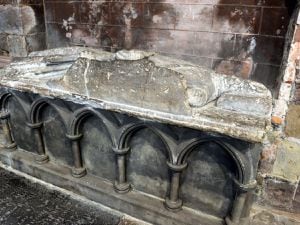Unusual stone carving could solve medieval mystery about Shropshire's past
An archaeologist uncovering a medieval mystery in the heart of rural Shropshire. It might sound a bit far-fetched, but read on and you’ll find out why a new theory about a peculiar stone carving could change the way we view our county’s history.

Long before there was a market in Cleobury Mortimer, Stottesdon was an economic hub – essentially the district capital or administrative centre of south-east Shropshire.
This goes some way to explaining why the village church seems so large. It currently seats around 150 people.
St Mary’s was just one of 23 churches recorded as being in Shropshire in the 1086 Domesday Book, which is a salient point.

Much of what you see today is Norman with local stone crudely carved into building blocks, but the church probably has Anglo-Saxon roots.
The fact it was one of just 23 mentioned around a thousand years ago is evidence of the church's importance following the Norman conquest.
"It is now very substantially a Norman building but there would not have been time to produce a completely new church and a new settlement between 1066 and 1086 so we can infer that there was an ecclesiastical building on the site before the conquest," explained Chris Tibbits, who directed recent restoration works at the church.
"Both the village and church were quite important in the great scheme of things because it was only one of 23 worth recording in the 1086 Domesday book."

Rare is a building so rich in history, which is why it’s Grade I-listed and has recently undergone some pretty spectacular restoration work - thanks to several fortunate funding mechanisms, including the National Lottery Heritage Fund, Shropshire Historic Churches Trust and other benefactors.
But hidden amongst the masterful masonry is a piece of artistic expression that has been many times overlooked, to the extent that the theory we are about to report has never been openly discussed before.
More on that shortly, but first we have to introduce the man behind the mystery.

Dr George Nash is an expert in prehistoric art and takes an active interest in medieval art, particularly that which was nearly lost to history during periods like the Reformation.
George was employed to conduct an archaeological survey during the construction work the church underwent last year. This was partly to ensure nothing valuable was destroyed or damaged, and partly to establish if anything important lay undiscovered beneath the surface.

It was during this work that George analysed one of the oldest and most significant pieces of history St Mary’s has to offer.
Located above a door between the tower and the nave is a tympanum, featuring some intricate medieval stonework.
Below the tympanum is a lintol with a mysterious hunting scene carved into the stone, and that's where the new theory about Shropshire's history comes into play.
The hunting scene artwork features a net and three big cats. The creatures were originally thought to be lions, but Dr Nash has suggested they could represent something far more relevant to the county's past – three leopards.
"Until George said they look remarkably like leopards, no one here had had that perspective," said Chris. "They're clearly cat-like things, but local tradition has it that one them looks like a deer. The feet are definitely cat paws in our judgment."
George said: "What we've got on here are 'three lions' but they're not lions – they're leopards. And what are the three emblems of the Shropshire flag? Leopards.
"This is the only place in Shropshire that I know of that features a piece of art with three whole leopard's bodies.
"The heads are more feline, more cat-like than a lion's which would have a mane, so they're either female lions, which is highly unlikely, or leopards," he continued.

Shropshire's flag was developed as the county council's banner of arms in 1895 and it features the faces of three leopards.
They are the traditional emblem of the county, but more associated specifically with Shrewsbury, the county town.
According to the Flag Institute, they "derive from the 15th century arms and seal of Shrewsbury, which display three lion heads".
You'll be hard-pressed to find much more information about the flag at all. But if George's theory is true, Shropshire's identity was being developed hundreds of years earlier.

And it's more significant than that.
This maybe, as George explained, the first artistic reference to three leopards in Shropshire's history and possibly in English history.
Lions were often referred to as 'leopards' in medieval heraldry and three lions were associated with various English monarchs from the 12th century onwards, which is why there is a good chance the work dates back to that time period.
It's also worth mentioning here that the King was presented with three leopards by the Holy Roman Emperor in 1235 so 13th century is a possibility for the origin of this hunting scene too.
The Historic Royal Palaces website says: "In 1235, Henry III (1216-72) was delighted to be presented with three 'leopards' (probably lions but referred to as leopards in the heraldry on the king's shield) by the Holy Roman Emperor Frederick II.
"These inspired the King to start a zoo at the Tower of London."
But because of the carving style, this work could also date back to as early as the 10th or 11th centuries, and could pre-date the Norman invasion.
"I think the style is Rustic Work, and that seems to be 950AD to 1050AD as the time frame, Chris said.
"That means the lintol could've been carved in the 10th or 11th century. It also means it could have come from somewhere else or relocated from another structure."
If it was carved in the 10th or 11th centuries, the carving could well be the foundation stone of Shropshire's identity and may well pre-date the Norman era.

Is this a reference to the three leopards that eventually found their way onto the Shropshire flag?
It's impossible to say for certain, but Stottesdon has another historic connection to Shrewsbury that might add weight to the theory.
Roger de Montgomery, who was William the Conqueror's cousin, fought at Hastings in 1066 and was later rewarded for that by being made the first Earl of Shrewsbury, purportedly oversaw the construction of the Norman stone church at Stottesdon and in re-enforcing Stottesdon's importance and power in the region.
According to Chris Tibbits, Roger de Montgomery "gifted the manor of Stottesdon to Shrewsbury Abbey, which he founded, as a source of income".

What makes the carving more intriguing is that it would seem the tympanum wasn’t always a tympanum but is in fact makeshift.
George and others believe the hunting scene was once a pillar standing up right, but was tipped onto its side and lifted into place to create the lintol. No doubt moved from elsewhere, it could be the oldest item in the church.

Other theories about the hunting scene range from the idea that they're not big cats at all but are in fact deer, to that the image is actually a moral tale aimed at an illiterate peasant audience.
It sat above the main door, after all, and would have had a profound impact on those passing into the building.
Mr Tibbits explained: "The artefact sits above what was the main entrance to the building before the tower was built, and the tower was built by the Normans, so the principle assumption is that the tympanum is remarkably old - possibly more than 1,000 years old."
"And since it was the main door it was probably a finger waving 'you'll end up like this if you aren't good'."
Most Salopians with a keen interest in history will no doubt be hoping it's true that this beautiful church in Stottesdon was where Shropshire's relationship with three leopards began.
St Mary's is very much still a successful working church, and thanks to the recent works, it has had its "At Risk" status removed by Heritage England. Good news to finish on.
*This article was based on conversations with Dr George Nash who came up with the theory about the three leopards and Chris Tibbits who oversaw the extensive restoration work at St Mary's Church, Stottesdon.





